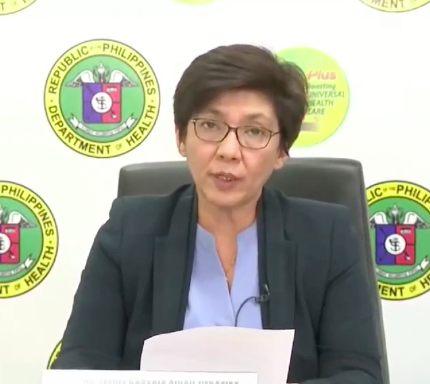
DOH Usec. Rosette Vergeire in an online press conference.
MANILA, Philippines — The Department of Health (DOH) on Friday said that home quarantine guidelines were released as early as April, and have been “emphasized” to local government units (LGUs), in response to Malacañang’s claims that the department failed to clarify the guidelines.
Health Undersecretary Maria Rosario Vergeire said in an online media forum that the DOH issued a memorandum as early as April 11, mandating barangay health emergency response teams or BHERTS to monitor suspect, probable, and confirmed cases of COVID-19 who are in isolation in their homes.
A Joint Administrative Order with the Interior Department on April 15 also declared that mild and symptomatic COVID-19 patients cannot quarantine at home if they do not have their own rooms, own bathrooms, and do not have any individual in their house that is considered vulnerable, she added.
“Since April 11 meron na po tayong nilabas na polisya galing po dito sa DOH. April 11 pa po yan. Na-supplement pa ‘yan dahil nagkaroon tayo ng Joint Administrative order with the DILG (Department of Interior and Local Government) noong April 15 ‘yan nilabas na talagang sinabi diyan ‘yung conditions natin na hindi ka pwedeng mag-home quarantine if these specific conditions were not met,” Vergeire told reporters.
(Since April 11, we already have a policy from the DOH. Since April 11. It was even supplemented because we had a Joint Administrative order with the DILG, it was released on April 15 that our conditions really said that you cannot go home quarantine if these specific conditions were not met.)
Malacañang earlier blamed the DOH’s alleged failure to clarify home quarantine guidelines for asymptomatic or mild COVID-19 patients as one of the reasons behind the spike of infections in the country.
In his regular press briefing in Malacañang on Thursday, presidential spokesperson Harry Roque said the Health Department “should have been clearer” about the guidelines for home quarantine from the start of the new coronavirus outbreak.
“I think hindi naging malinaw kasi ‘yung sinabi ng DOH that asymptomatic and the mild (cases) can stay home. Hindi nila nilinaw na you must have your own room and bathroom,” Roque said.
(I think it was not clear when the DOH said that asymptomatic and mild cases can stay home. They did not make it clear enough that you must have your own room and bathroom.)
“Kaya sa tingin ko, isa sa mga dahilan ito kaya tumaas ang numero natin. But we’re rectifying it now. We have fully intensified our testing,” he went on.
(That’s why I think this is among the reasons our numbers increased. But we’re rectifying it now. We have fully intensified our testing.)
But Vergeire stressed that the policy was discussed and “emphasized” to local government units during various meetings amid the COVID-19 pandemic.
“Whenever we have townhall meetings with the local governments, we always emphasized on this na hindi ka pwedeng maghome quarantine kung wala kang sariling kwarto o kaya sariling banyo at meron kayong vulnerable sa bahay,” Vergeire said.
(Whenever we have townhall meetings with the local governments, we always emphasized on this that you cannot quarantine at home if you do not have your own room or your own bathroom and you have a vulnerable person at home.)
“’Yan naman ay ini-emphasize namain sa kanila kailangan meron kayong sariling ligtas COVID centers so you can put or you can place itong ating mga suspects, probable at confirmed dito sa mga quarantine facilities sa local government,” she added.
(We emphasize to them that you need to have your own COVID quarantine centers so you can put or you can place these suspects, probable and confirmed cases there.)
The government earlier discouraged home quarantine and launched its Oplan Kalinga program where mild and symptomatic COVID-19 patients whose houses are not equipped for home quarantine are transferred to state quarantine facilities.
The Philippines’ COVID-19 caseload hit 74,390 on Thursday with the addition of 2,200 more infections. Meanwhile, 24,282 people have recovered from the respiratory disease although 1,871 died.